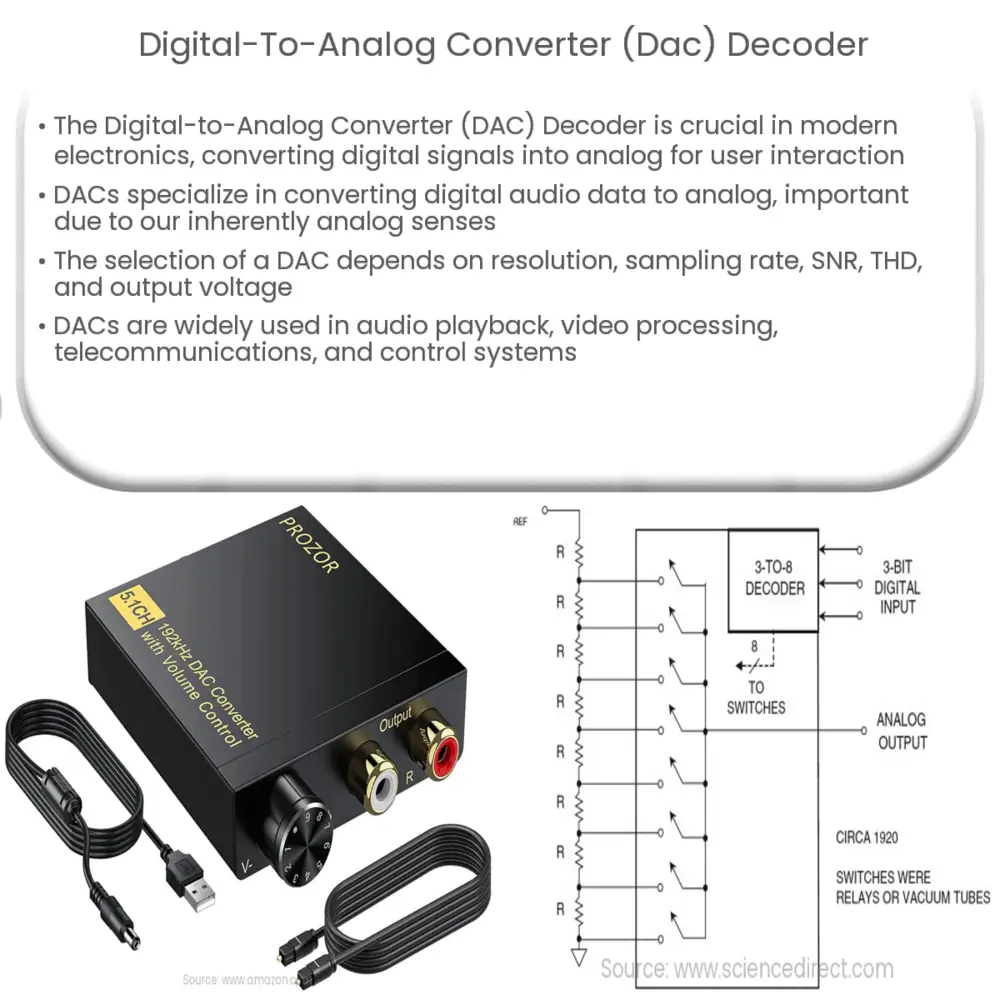A DAC Decoder converts digital signals into analog signals, enabling devices like music players & TVs to produce sound or display images.

Digital-to-Analog Converter (DAC) Decoder: An Essential Component in Modern Electronics
Introduction
The rapid evolution of technology has led to the proliferation of digital devices that have become an integral part of our daily lives. From smartphones and computers to music players and television sets, these digital gadgets have transformed the way we interact with the world. A crucial component in the functionality of these devices is the Digital-to-Analog Converter (DAC) Decoder, which allows us to experience and interact with digital information in a meaningful way.
What is a Digital-to-Analog Converter (DAC) Decoder?
A Digital-to-Analog Converter, or simply DAC, is an electronic device that converts digital signals into analog signals. Digital signals are binary in nature, represented by a series of 0s and 1s, while analog signals are continuous and can take any value within a specified range. A DAC Decoder is a specialized type of DAC designed to convert digital audio data into analog audio signals that can be played back through speakers or headphones.
Why is a DAC Decoder important?
Most modern electronic devices process and store information in digital format, as it offers several advantages over analog format, such as improved signal-to-noise ratio, better error detection, and correction capabilities. However, human senses, such as hearing and vision, are inherently analog. For us to perceive digital information, it must first be converted into an analog format that can be processed by our senses.
In the context of audio playback, for example, digital audio files need to be converted into analog audio signals that can drive speakers or headphones. This conversion is carried out by a DAC Decoder, making it an essential component in modern audio systems.
How does a DAC Decoder work?
A DAC Decoder operates by receiving a digital input signal, which is essentially a sequence of binary numbers representing the amplitude of the audio waveform at discrete time intervals. The DAC Decoder processes this digital data and generates a corresponding continuous analog waveform by mapping each digital value to a corresponding analog voltage level. This analog signal can then be amplified and sent to speakers or headphones to produce sound.
Types of DAC Decoders
There are several types of DAC Decoders, each employing different methods to achieve digital-to-analog conversion. Some common types include:
- Resistor Ladder DACs: Also known as R-2R Ladder DACs, these devices utilize a network of resistors arranged in a ladder-like configuration to generate analog output voltages corresponding to digital input values.
- Delta-Sigma DACs: These DACs use a combination of oversampling, noise shaping, and digital filtering techniques to produce highly accurate analog outputs with low distortion and noise.
- Pulse-Width Modulation (PWM) DACs: PWM DACs convert digital input values into varying pulse widths, which are then smoothed out by a low-pass filter to produce the desired analog output waveform.
Selecting the Right DAC Decoder
When choosing a DAC Decoder for a particular application, several factors should be taken into consideration, such as:
- Resolution: The resolution of a DAC Decoder refers to the number of discrete steps it can represent in the analog output. Higher resolution DACs provide finer granularity in the conversion process, resulting in more accurate analog signals.
- Sampling Rate: The sampling rate determines the maximum frequency that can be accurately represented by the DAC Decoder. To avoid aliasing and accurately reproduce the original analog signal, the sampling rate should be at least twice the highest frequency component in the input signal.
- Signal-to-Noise Ratio (SNR) and Total Harmonic Distortion (THD): These specifications are measures of the noise and distortion introduced by the DAC Decoder during the conversion process. Higher SNR and lower THD values indicate better performance and audio fidelity.
- Output Voltage Range and Impedance: The output voltage range and impedance of the DAC Decoder should be compatible with the input requirements of the subsequent amplification stage or the transducer (e.g., headphones or speakers) being used.
Applications of DAC Decoders
DAC Decoders play a crucial role in a wide variety of applications, including:
- Audio Playback: DAC Decoders are used in music players, smartphones, computers, and other devices to convert digital audio files into analog signals that can be played back through speakers or headphones.
- Video Processing: In video systems, DAC Decoders convert digital video data into analog signals for display on CRT monitors or for transmission over analog video interfaces such as VGA or composite video.
- Telecommunications: DAC Decoders are used in digital communication systems to convert digitally modulated signals into analog signals suitable for transmission over analog channels or for processing by analog components.
- Control Systems: In industrial and automation applications, DAC Decoders are often used to generate analog control signals based on digital input data, enabling precise control of motors, valves, and other devices.
Conclusion
The Digital-to-Analog Converter (DAC) Decoder is an indispensable component in modern electronics, allowing us to experience and interact with digital information in an intuitive and meaningful way. As digital technology continues to advance and find its way into more aspects of our lives, the importance of DAC Decoders and the need for further innovation in this field will only grow. Understanding the fundamentals of DAC Decoders and their various applications is essential for engineers, designers, and enthusiasts alike to harness the full potential of digital technology and create more advanced, efficient, and user-friendly devices.

